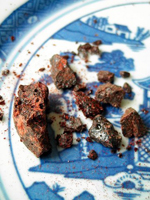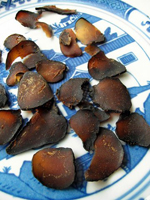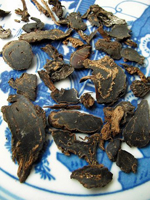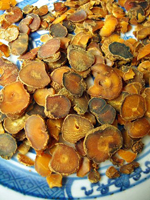Cancer pain takes many forms. It may be caused when a tumor presses on bone, nerves or organs. In addition, certain painful conditions are due to cancer treatment including chemotherapy, radiotherapy and surgery. Sometimes patients may experience headaches and muscle pain that has nothing to do with the illness or treatment. According to TCM understanding, cancer pain can be classified in two major categories.
- Obstructive pain: this is due to one or several evils attacking an organ or meridian leading to sluggish flows of qi (vital energy) or blood in the region. The pain is usually sharp, relatively localized, and with certain characterisitics. See the "nature of paint". TCM therapies will aim at removing the stagnation so as to resume smooth circulation.
- Deficient pain: due to the progressive exhaustion of cancerous tissues, the other healthy tissues inside the body generally lack nutrient supply for normal functioning. This always causes dull pain that occurs gradually but persistently and relatively less localized. TCM therapies will aim at nourishing the organs and meridians as well as replenishing blood and qi.
TCM local remedies are mainly targeted on obstructive type of pain. The selected drugs are mostly chosen from insects, worms, living animal parts or toxic substances; TCM holds that these categories can activate blood and qi, removing stasis and coldness, warming meridians and relieving pain. In addition, certain anti-cancer herbs, or herbs with warming and stimulant properties are added to the prescriptions to have more broaden effects. Common ingredients are:
 Centipede Centipede |
 Scorpion Scorpion |
 Resinous secretion Resinous secretion |
 Common Monkshood mother root Common Monkshood mother root |
 Kusnnezoff Monkshood root Kusnnezoff Monkshood root |
 Corydalis Rhizome Corydalis Rhizome |
| chan su |
Dried toad venom |
Venenum Bufonis |
| di long |
Earthworms |
Lumbricus |
| wu gong |
Centipede |
Scolopendra |
| quan jie |
Scorpion |
Scorpio |
| tu bie chong |
Ground beetles |
Eupolyhpaga seu Steleophaga |
| xiong huang |
Realgar |
Realgar |
| bing pian |
Borneol |
Borneolum Syntheticum |
| she xiang |
Musk |
Moschus |
| ru xiang |
Frankincense |
Olibanum |
| mo yao |
Myrrh |
Resina Commiphorae Myrrhae |
| xue jie |
Resinous secretion |
Resina Draconis |
| chuan wu |
Common Monkshood mother root |
Radix Aconiti |
| cao wu |
Kusnnezoff Monkshood root |
Radix Aconiti Kusnezoffii |
| ma qian zhi |
Nux vomica |
Semen Strychni |
| bai qu cai |
Greater Celandine Herb |
Herba Chelidonii |
| yan hu suo |
Corydalis Rhizome |
Rhizoma Corydalis |
| xi xin |
Manchurian wildginger |
Herba Asari |
In addition to application on painful areas, these drugs are also applied to specific acupoints on the trunk. It is said that this can promote
meridian flow to obtain a general regulating effect, which readjusts neural sensitivity to lower the threshold of pain. Some of the selected acupoints are:
| Origin of pain |
Selected acupoints |
| Nasopharyngeal cancer |
Da-zhui, feng-chi, fei-shu, shen-que |
| Esophagus cancer |
Ge-shu, shen-que, |
| Lung or skin cancer |
Fei-shu, ru-gen, shen-que |
| Liver cancer |
Qi-men, gan-shu |
| Gall bladder cancer |
Dan-shu |
| Stomach cancer |
Wei-shu, zhong-wen, shen-que |
| Intestinal cancer |
Da-chang-shu, shen-que |
| Pancreatic cancer |
Pi-shu, shen-que, |
| Cervical cancer |
Shen-que, shen-shu |
| Bladder cancer |
Shen-shu, pang-guang-shu, shen-que |

Shen-que (umbicius) is an important acupoint in TCM local application.
It is said that pain alleviation can be achieved in a short time, last for relatively longer period and have few side effects.
 Centipede
Centipede Scorpion
Scorpion Resinous secretion
Resinous secretion Common Monkshood mother root
Common Monkshood mother root Kusnnezoff Monkshood root
Kusnnezoff Monkshood root Corydalis Rhizome
Corydalis Rhizome Shen-que (umbicius) is an important acupoint in TCM local application.
It is said that pain alleviation can be achieved in a short time, last for relatively longer period and have few side effects.
Shen-que (umbicius) is an important acupoint in TCM local application.
It is said that pain alleviation can be achieved in a short time, last for relatively longer period and have few side effects.


